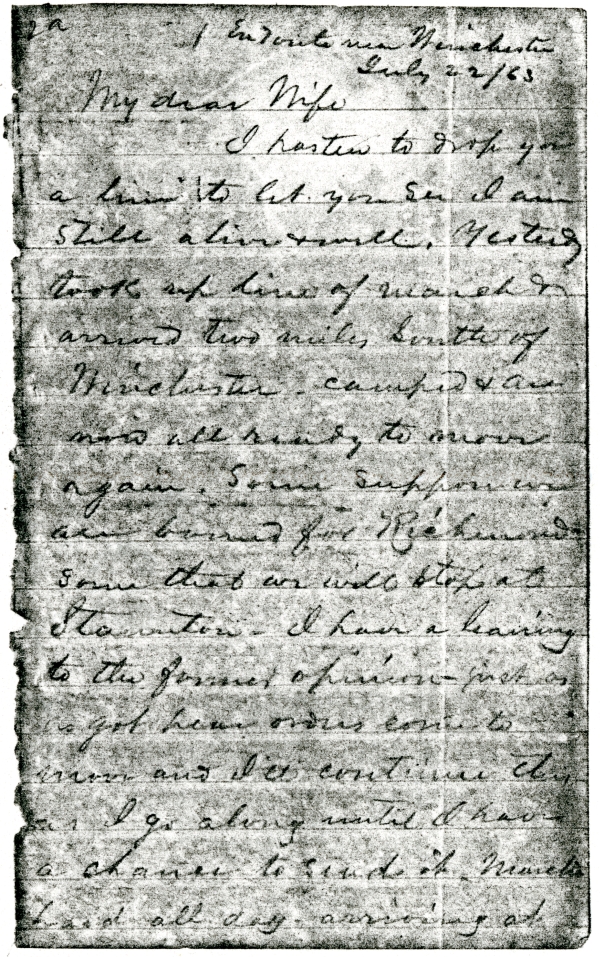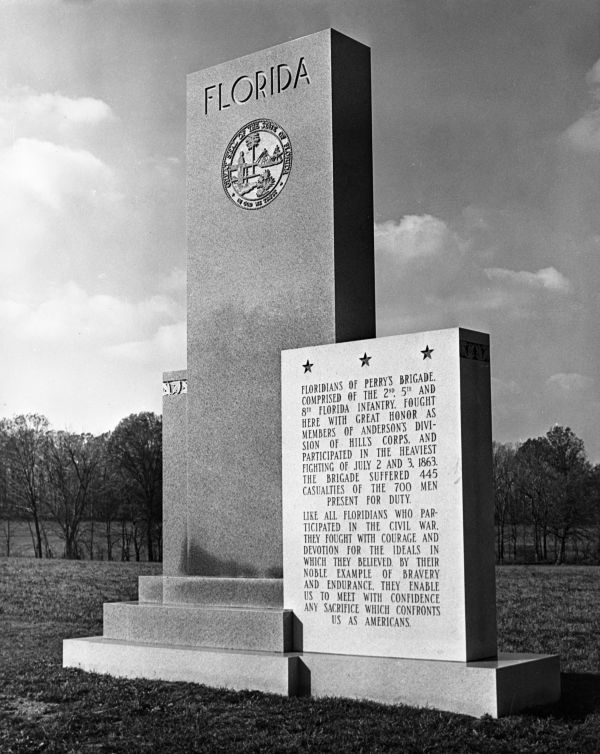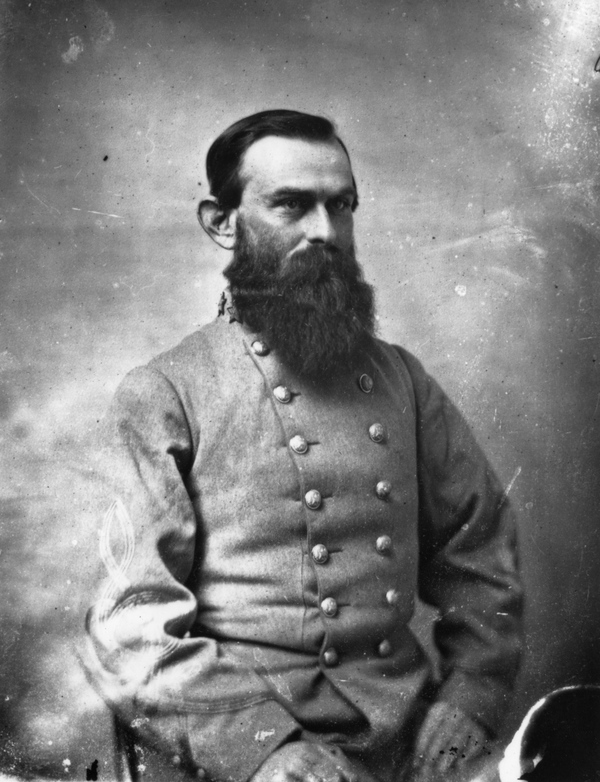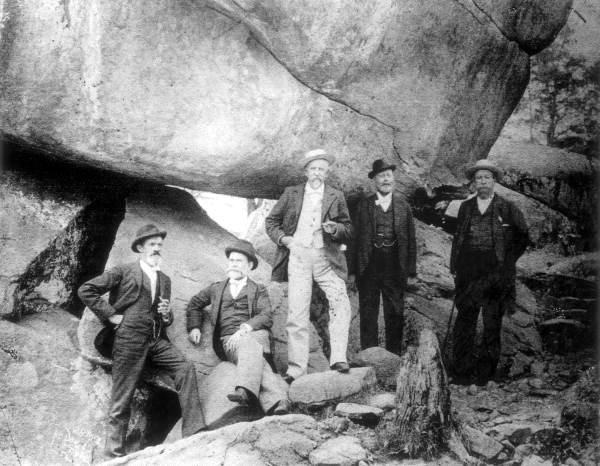Description of previous item
Description of next item
The Florida Brigade at Gettysburg
Published July 7, 2013 by Florida Memory
The monument commemorating the service of Florida Confederate soldiers at Gettysburg was dedicated on July 3, 1963, during ceremonies marking the 100th anniversary of the Civil War's most famous battle.
Standing along West Confederate Avenue in Gettysburg National Military Park, the gray rectangular piece of granite brings to mind a headstone more than heroics. The effect is apt. Of the 742 men in the three regiments that made up the Florida Brigade at the beginning of the Battle of Gettysburg on July 1, 1863, 461 were casualties (killed, wounded, or captured) at the end of the battle on July 3. In losing 62 percent of its strength, the Florida Brigade suffered a higher rate of loss than any other Confederate brigade in the battle. The Floridians' role in the Battle of Gettysburg was but one of countless examples of sacrifice and slaughter performed by Union and Confederate troops during the three days of carnage that was the Battle of Gettysburg.
Also known as "Perry's Brigade" for its commander General Edward A. Perry, who had led the three Florida infantry regiments (2nd, 5th, and 8th) since November 1862, the Florida Brigade made up one of the five brigades of Major General Richard H. Anderson's Division, one of three divisions within the Army of Northern Virginia's Third Corps under Lieutenant General A. P. Hill. The Third Corps began its march into Northern territory on June 23, 1863, as part of General Robert E. Lee's campaign to bring the war to the North by leading the Army of Northern Virginia into southeastern Pennsylvania. A week later, on July 1, 1863, the leading infantry units of Lee's army met forward units of the Union's Army of the Potomac on the western edge of the small market town of Gettysburg, in what would be the first of three days of fighting.
Anderson's Division and its Floridians did not fight on July 1. The division was too far in the rear of Hill's Third Corps to engage the Federals. The next day was different. After retreating to high ground south of Gettysburg on July 1, on the morning of July 2, the Union line formed a fishhook running from the northeast at Culp's Hill (the hook of the fishhook) to Cemetery Hill (the bulge of the hook) and down along Cemetery Ridge (the straight arm of the hook), ending at the Round Tops at the southern end of the ridge. Lee planned for his army to attack the entire length of the fishhook on July 2, in a series of assaults running from the Round Tops to Culp's Hill.
General James Longstreet's First Corps began the attack by hitting Union regiments defending the area along Cemetery Ridge from the Round Tops to Cemetery Hill. As the Confederate attack rolled north, Anderson's Division joined in by assaulting Federal units that had moved into exposed positions in front of Cemetery Ridge and against units on the ridge itself. Longstreet's corps spent most of the day of July 2 moving into position. His units facing the Round Tops did not begin their attack until 3 p.m. After that attack failed, at 5 p.m., Anderson's Division on the left wing of Longstreet's corps began its assault on the Union line.
The Florida Brigade went into the attack minus its commander. General Perry caught typhoid fever in the days leading up to the battle and had to relinquish command to Colonel David Lang, who now led the Florida Brigade before Cemetery Ridge. The Floridians went into battle arrayed between Brigadier Ambrose R. Wright's Georgia Brigade on the left and Cadmus M. Wilcox's Alabama Brigade on the right. According to Colonel Lang, the Floridians"dashed across an open field 1½ miles wide every foot of which was swept by the enemy's artillery and musketry." After pushing back Union troops fighting in front of Cemetery Ridge, the Florida Brigade"captured a large number of their cannon" before being forced to retreat by a Union attack coming from the right. The Floridians' withdrawal reflected the failure of the entire Confederate effort to break the Union lines on July 2.
On July 3, General Lee planned to launch another general assault. This time, however, the focus of the attack would be in the center where he planned to launch a massive frontal attack against Cemetery Ridge. Best known for General George E. Pickett's Virginia division's horrendously costly and failed charge against the ridge, the Confederate attack on July 3 saw charges by several other state units, including the Florida Brigade. Colonel Lang witnessed the start of the attack which began with a tremendous bombardment of the Union lines by more than 300 Confederate cannons, which"were being discharged as fast as they could be loaded & fired, and the noise was so great that one could not carry on a conversation with his nearest neighbor." Even after the failure of"Pickett's Charge" made it obvious that the Confederate strategy had failed, Lang's Floridians and Wilcox's Alabamians were ordered to attack the Federals on the ridge. The Floridians"went into it gallantly to within a short distance of the enemy's entrenchments when they were again outflanked and compelled to retire."

Letter from Council A. Bryan to his wife, Cornelia Screven Bryan, on the Florida Brigade's Retreat from Gettysburg, 1863
Although both armies were exhausted at the end of the day's fighting on July 3, with combined losses approaching 50,000 men, the Confederates had failed to break the Army of the Potomac and were forced to leave the North and retreat into Virginia. Defeat at Gettysburg, combined with the surrender of Vicksburg on the Mississippi River to Union forces on July 4, 1863, was a devastating psychological and material blow to the Confederacy. Yes, the Confederate States continued to fight until the spring of 1865, but never recovered the vitality or renewed the manpower that allowed it to invade the North in the summer of 1863. If Gettysburg was not the beginning of the end of the Confederacy it was, as Winston Churchill said of the British victory over the Germans at El Alamein in the Second World War,"the end of the beginning."
Cite This Article
Chicago Manual of Style
(17th Edition)Florida Memory. "The Florida Brigade at Gettysburg." Floridiana, 2013. https://www.floridamemory.com/items/show/260502.
MLA
(9th Edition)Florida Memory. "The Florida Brigade at Gettysburg." Floridiana, 2013, https://www.floridamemory.com/items/show/260502. Accessed January 1, 2026.
APA
(7th Edition)Florida Memory. (2013, July 7). The Florida Brigade at Gettysburg. Floridiana. Retrieved from https://www.floridamemory.com/items/show/260502

 Listen: The Blues Program
Listen: The Blues Program

